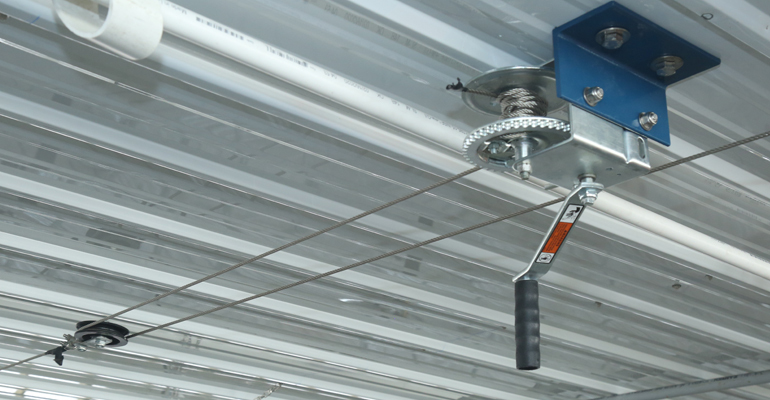



How to manage varying air flows with actuated ceiling inlets
The changing weather can present a challenge for building airflowChanging weather makes ventilation management more complex. The more the temperature swings, the more the fans switch off and on, varying the airflow needed.
When the outside temperatures are below the inside target temperature, we bring the air in at high velocity and mix it with the warm air layer found along the ceiling before it tumbles to the animal level below. The longer these air jets travel, the warmer and drier they become. Lower airspeeds mean the jets don't travel as far, causing pig-level drafts.
Many older buildings incorporated gravity flow ceiling inlets for minimum and mild weather ventilation rates. This inlet style maintains adequate airspeeds (above 700 fpm) when operated with at least half its maximum rated cfm rate. The problem with gravity inlets surfaces when the amount of required air drops too low.
Take the example of a 1,200-head finishing needing 48,000 cfms for mild winter ventilation. To supply this requirement, we would need to install 24 quad inlets rated at 2,000 cfm. The individual vanes would be open four inches when each inlet provides its maximum of 2,000 cfm. During very cold weather, the required cfms may drop as low as five cfm/head or 6,000 cfm total. Each inlet now supplies 250 cfm and will only be open about 1/2 inch.
Small openings produce thin air streams that become too turbulent and will not travel far enough to mix properly. Baffle openings should be at least one inch to create larger air streams with sufficient mass to travel across the ceiling to provide good mixing.

The remedy for this is easy: lock up some of the inlets, so the remaining ones open far enough to throw and mix the cold incoming air. Of course, you'll need to open them back up again when the day's weather warms up.
The same 1,200-head finishing building would require 16) 3,000 cfm actuated bifold inlets. The inlets would be completely open at over eight inches during full mild weather ventilation. At the lower rate of 6,000 cfm, each inlet flap would be open approximately 1-1/2 inches, giving the air enough force to travel along the ceiling and increase temperature.
Actuated inlets will also help manage the transition period as the weather warms up in tunnel-ventilated buildings. Gravity inlets remain open as the building switches to tunnel mode, pulling hot air from the ceiling when it is not needed. With machine-actuated inlets, the house controller closes inlets when shifting the system to tunnel mode.
Best practices for installing actuated inlets
The most common automatic inlet controllers are linear actuators, used for shorter runs and fewer inlets, and curtain machines used where more power is needed.

Always limit the total length of each run to 100' or less. For example, in a 200' long building, place the machine in the middle and separate the run into two sections.

Installing a winch into the actuator cabling provides easier adjustment of the inlets.
Using a solid rod wire instead of cable reduces stretching in the run, allowing more accurate calibration of the inlet doors.
Machine-actuated inlets reduce the labor needed to manage inlets during rapidly changing weather conditions occurring in spring and fall. Click for more information on linear actuators, curtain machines, and ceiling inlets.








